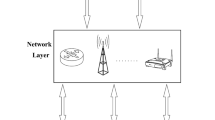Abstract
Wireless Sensor Networks (WSNs) are foundation of Internet of things (IoT). Sensors are mainly deployed for collecting data which will be transmitted to IoT servers. In trying to prevent unauthorized users from stealing, faking even destroying data, it is critical to design a secure data transmission scheme for WSNs in the IoT. In recent years, a great many data transmission schemes have been put forward successively, however, most of these schemes required the sender and the receiver to be in the same network domain, or to share the same system parameters in different environments. Moreover, almost all of data transmission schemes cannot achieve known session-specific temporary information security (KSSTIS). For solving these problems, we proposed a data transmission scheme for WSNs in heterogeneous IoT environment by using heterogeneous ring signcryption. The data transmission scheme allows WSN node under the circumstance of certificateless cryptography (CLC) to transmit the collected data to an IoT server under the public key infrastructure (PKI) environment with different cryptographic system parameters. The proposed scheme which proves to be safe under the Computational Diffie-Hellman (CDH) problem in the random oracle model. Also, the proposed data transmission scheme is practical for wireless sensor networks in heterogeneous IoT environment through the efficiency analysis.

Similar content being viewed by others
References
Yaqoob, I., Ahmed, E., Abaker, I., et al. (2017). Internet of things architecture: Recent advances, taxonomy, requirements, and open challenges. IEEE Wireless Communications, 24(3), 10–16.
Sethi, P., & Sarangi, S. R. (2017). Internet of things:architectures, protocols, and applications. Journal of Electrical and Computer Engineering. https://doi.org/10.1155/2017/9324035.
Lin, J., Yu, W., Zhang, N., Yang, X., Zhang, H., & Zhao, W. (2017). A survey on internet of things: architecture, enabling technologies, security and privacy, and applications. IEEE Internet of Things Journal, 4(5), 1125–1142.
Conti, M., Dehghantanha, A., Franke, K., & Watson, S. (2018). Internet of things security and forensics: Challenges and opportunities. Future Generation Computer Systems, 78, 544–546.
Kouicem, D. E., Bouabdallah, A., & Lakhlef, H. (2018). Internet of things security: A top-down survey. Computer Networks, 141, 199–221.
Huang, X., Susilo, W., Mu, Y., & Zhang, F. (2005). Identity-based ring signcryption schemes: Cryptographic primitives for preserving privacy and authenticity in the ubiquitous world. In Advanced Information Networking and Applications-AINA. (pp. 649–654). Taiwan, Taipei.
Sharma, G., Bala, S., & Verma, A. K. (2017). PF-IBS: pairing-free identity based digital signature algorithm for wireless sensor networks. Wireless Personal Communications, 97(1), 1185–1196.
Khan, H. (2018). An identity based routing path verification scheme for wireless sensor networks. International Journal of Sensor Networks, 26(1), 1–15.
Zhu, H. F., Tan, Y. A., Zhu, L. H., et al. (2018). An identity-based anti-quantum privacy-preserving blind authentication in wireless sensor networks. Sensors, 18(5), 1–15.
Al-Riyami, S. S., & Paterson, K. G. (2003). Certificateless public key cryptography. In International Conference on the Theory and Application of Cryptology and Information Security (pp. 452–473). Springer Berlin Heidelberg.
Wang, L., Zhang, G., & Ma, C. (2007). A secure ring signcryption scheme for private and anonymous communication. In Proceedings of the IFIP international conference on network and parallel computing workshops, NPC’07, (pp. 107–111).
Zhu, L.J., Zhang, F., & Miao, S. (2010). A provably secure parallel certificatelesss ring signcryption scheme. In Proceedings of the international conference on multimedia information networking and security, MINES’10, (pp. 423–427).
Qi, Z. H., Yang, G., & Ren, X. Y. (2011). Provably secure certificateless ring signcryption scheme. China Communications, 8(3), 99–106.
Sharma, G., Bala, S., & Verma, A. K. (2015). Pairing-free certificateless ring signcryption (PF-CLRSC) scheme for wireless sensor networks. Wireless Personal Communications, 84, 1469–1485.
Shen, H., Chen, J. H., He, D. B., & Shen, J. (2017). Insecurity of a pairing-free certificateless ring signcryption scheme. Wireless Personal Communications, 96, 5635–5641.
Li, F., Zheng, Z., & Jin, C. (2016). Secure and efficient data transmission in the internet of things. Telecommunication Systems, 62(1), 111–122.
Omala, A. A., Mbandu, A. S., Mutiria, K. D., Jin, C., & Li, F. (2018). Provably secure heterogeneous access control scheme for wireless body area network. Journal of Medical Systems, 42(6), 1–14.
Luo, M., Luo, Y., Wan, Y. W., & Wang, Z. (2018). Secure and efficient access control scheme for wireless sensor networks in the cross-domain context of the IoT. Security and Communication Networks. https://doi.org/10.1155/2018/6140978.
Acknowledgements
This work is supported by the National Natural Science Foundation of China (No. 61662046) and the scientific research project of Jiangxi Province of China (Nos. 20171BCB23014, 20181BCD40005).
Author information
Authors and Affiliations
Corresponding author
Additional information
Publisher's Note
Springer Nature remains neutral with regard to jurisdictional claims in published maps and institutional affiliations.
Rights and permissions
About this article
Cite this article
Luo, M., Wen, Y. & Hu, X. Practical Data Transmission Scheme for Wireless Sensor Networks in Heterogeneous IoT Environment. Wireless Pers Commun 109, 505–519 (2019). https://doi.org/10.1007/s11277-019-06576-8
Published:
Issue Date:
DOI: https://doi.org/10.1007/s11277-019-06576-8




